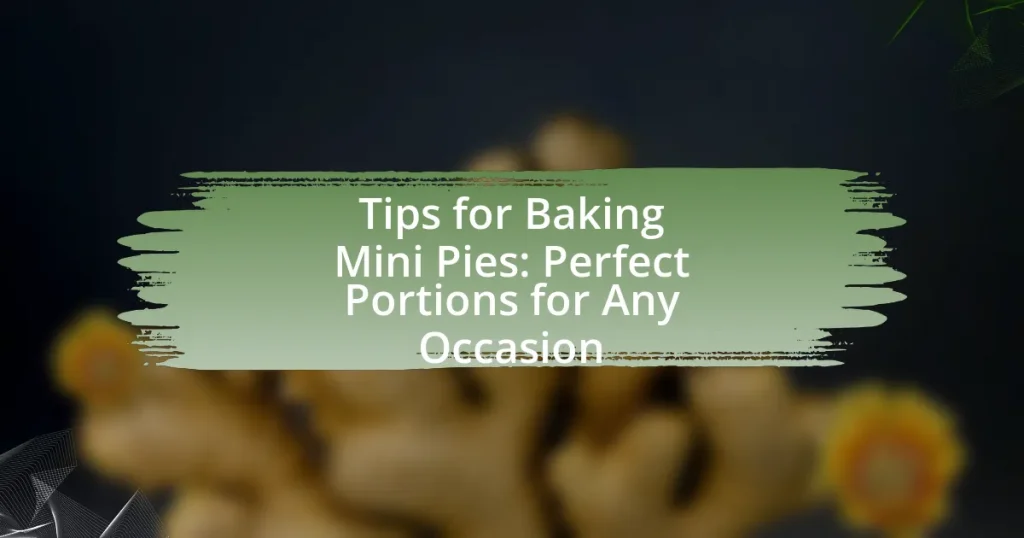Mini pies are individual-sized pastries that have gained popularity due to their convenience, versatility, and suitability for various occasions. This article provides essential tips for baking mini pies, including differences from regular pies, advantages of portion control, and types of fillings and crusts. It also covers best practices for preparing fillings, enhancing presentation, and troubleshooting common baking issues. By following these guidelines, bakers can create delicious mini pies that cater to diverse tastes and are perfect for any gathering or celebration.

What are Mini Pies and Why are They Popular?
Mini pies are small, individual-sized pastries filled with various sweet or savory ingredients, designed for convenient consumption. Their popularity stems from their portability, versatility in flavors, and the ability to serve them at various occasions, such as parties, picnics, and holidays. Additionally, mini pies allow for portion control, making them appealing for those seeking smaller dessert options or varied flavors without committing to a full-sized pie. The trend of mini desserts has been supported by consumer preferences for bite-sized treats, as evidenced by the growing market for single-serving desserts, which has seen a significant increase in sales over recent years.
How do Mini Pies differ from Regular Pies?
Mini pies differ from regular pies primarily in size and portioning. Mini pies are typically designed to serve one person, making them more convenient for individual servings, while regular pies are larger and intended to be sliced into multiple servings. This difference in size allows mini pies to bake more quickly and can result in a different texture, as the crust-to-filling ratio is altered. Additionally, mini pies often cater to specific dietary preferences or occasions, providing variety in flavors and fillings that may not be practical in larger pies.
What are the advantages of baking Mini Pies?
Baking mini pies offers several advantages, including portion control, versatility, and quicker baking times. Portion control allows for easy serving sizes, making them ideal for gatherings or individual treats. The versatility of mini pies enables bakers to experiment with various fillings and crusts, catering to diverse tastes and dietary preferences. Additionally, mini pies typically bake faster than their larger counterparts, reducing overall preparation time and allowing for quicker enjoyment. These benefits make mini pies a practical choice for any occasion.
What occasions are best suited for Mini Pies?
Mini pies are best suited for occasions such as parties, holidays, and gatherings. Their small size makes them ideal for serving as bite-sized desserts at events like birthday parties, weddings, and family reunions, where guests appreciate a variety of flavors without committing to a full slice. Additionally, mini pies are popular during holidays like Thanksgiving and Christmas, as they offer a festive touch and can be easily shared among guests. Their versatility and ease of serving make them a favored choice for any celebration that involves socializing and sharing food.
What types of Mini Pies can you bake?
You can bake various types of mini pies, including fruit mini pies, cream mini pies, and savory mini pies. Fruit mini pies often feature fillings like apple, cherry, or blueberry, utilizing fresh or canned fruits combined with sugar and spices. Cream mini pies, such as chocolate or coconut cream, typically consist of a custard base topped with whipped cream. Savory mini pies, like chicken pot pie or quiche, incorporate meats, vegetables, and cheeses in a flaky crust. Each type offers unique flavors and textures, making them suitable for different occasions.
What are the most popular fillings for Mini Pies?
The most popular fillings for mini pies include apple, cherry, blueberry, and pumpkin. These fillings are favored due to their widespread appeal and traditional use in pie-making. For instance, apple pie is a classic dessert in American cuisine, often made with a mix of tart and sweet apples, while cherry and blueberry pies are celebrated for their vibrant flavors and natural sweetness. Pumpkin pie, particularly popular during the fall season, is made from spiced pumpkin puree and is a staple at Thanksgiving. These fillings not only enhance the taste but also cater to various seasonal preferences, making them ideal choices for mini pies.
How can you customize Mini Pies for different tastes?
You can customize Mini Pies for different tastes by varying the fillings, crusts, and toppings. For fillings, consider using fruits like apples, berries, or peaches, or opt for savory options such as spinach and cheese or chicken pot pie. Different crusts, such as traditional pastry, graham cracker, or even gluten-free options, can also cater to diverse preferences. Additionally, toppings like whipped cream, ice cream, or a sprinkle of cinnamon can enhance the flavor profile. This approach allows for a wide range of flavor combinations, accommodating various dietary needs and personal preferences.

What Essential Tips Should You Follow for Baking Mini Pies?
To successfully bake mini pies, ensure you use a reliable pie crust recipe, as a well-made crust is crucial for texture and flavor. Choose a crust that is easy to handle and can hold the filling without becoming soggy. Additionally, pre-bake the crusts for about 10 minutes to set them before adding the filling, which helps prevent sogginess. Use a variety of fillings, such as fruits or custards, but ensure they are not too liquid to avoid overflow. Finally, monitor the baking time closely, as mini pies typically require less time than standard pies; check for a golden-brown crust and bubbling filling to determine doneness.
How do you choose the right crust for Mini Pies?
To choose the right crust for mini pies, select a crust that complements the filling and maintains structural integrity. A flaky pie crust works well for fruit fillings, while a cookie crust is ideal for creamy fillings like cheesecake. The choice of crust should also consider the baking method; for example, a pre-baked crust is suitable for no-bake fillings, ensuring the mini pie holds its shape and flavor.
What types of crusts work best for Mini Pies?
The best types of crusts for mini pies are flaky pastry crusts and crumb crusts. Flaky pastry crusts, made from butter, flour, and water, provide a tender and crisp texture that complements various fillings. Crumb crusts, typically made from crushed cookies or graham crackers mixed with butter, offer a sweet and crunchy alternative that pairs well with fruit or cream fillings. Both crust types are popular for mini pies due to their ability to hold shape while delivering a satisfying bite.
How can you ensure a flaky crust for your Mini Pies?
To ensure a flaky crust for your mini pies, use cold ingredients and minimal handling of the dough. Cold butter or shortening creates steam during baking, which leads to flakiness, while limiting the mixing time prevents gluten development that can make the crust tough. Research shows that keeping the dough chilled and incorporating fat in small pieces results in a superior texture, as supported by culinary studies emphasizing the importance of temperature control in pastry making.
What are the best practices for filling Mini Pies?
The best practices for filling mini pies include using a balanced filling that complements the crust, ensuring the filling is not too wet to prevent sogginess, and pre-cooking certain fillings to enhance flavor and texture. A balanced filling, such as a mix of fruits with sugar and spices, ensures even distribution and optimal taste. Keeping the filling dry, by using thickening agents like cornstarch or flour, helps maintain the integrity of the crust during baking. Pre-cooking fillings, particularly those with high moisture content like berries, allows for better flavor development and reduces the risk of a soggy bottom crust.
How do you properly prepare fillings for Mini Pies?
To properly prepare fillings for mini pies, start by selecting fresh, ripe ingredients that complement each other, such as fruits, nuts, or savory components. For fruit fillings, wash, peel, and chop the fruit into small, uniform pieces to ensure even cooking. Combine the fruit with sugar, spices, and a thickening agent like cornstarch or flour, allowing the mixture to sit for about 15 minutes to release juices and enhance flavor. For savory fillings, sauté vegetables and proteins to develop flavors, then mix with seasonings and a binding agent like cheese or cream. This method ensures that the fillings are flavorful and have the right consistency for mini pies.
What are common mistakes to avoid when filling Mini Pies?
Common mistakes to avoid when filling mini pies include overfilling, which can cause the filling to overflow during baking, and underfilling, leading to a dry pie. Additionally, not allowing the filling to cool before adding it to the crust can result in a soggy bottom. Using the wrong type of filling, such as overly watery fruits without proper thickening agents, can also lead to undesirable textures. Lastly, neglecting to seal the edges properly can result in leaks and loss of filling during baking. These mistakes can significantly affect the overall quality and presentation of the mini pies.

How can you enhance the presentation of Mini Pies?
To enhance the presentation of mini pies, use decorative elements such as fresh fruit, edible flowers, or a dusting of powdered sugar. These additions not only elevate the visual appeal but also complement the flavors of the pies. For example, placing a slice of berry on top or surrounding the pie with mint leaves can create an inviting look. Additionally, using colorful pie dishes or serving on a rustic wooden board can further enhance the overall presentation. Studies in food aesthetics indicate that visually appealing dishes can increase perceived taste and enjoyment, reinforcing the importance of presentation in culinary experiences.
What decorative techniques can you use for Mini Pies?
You can use several decorative techniques for mini pies, including lattice crusts, cut-out shapes, and egg wash glazing. Lattice crusts involve weaving strips of dough over the filling, creating an appealing pattern while allowing steam to escape. Cut-out shapes, such as leaves or stars, can be placed on top of the pie for added visual interest. Applying an egg wash before baking gives the crust a golden, shiny finish. These techniques enhance the aesthetic appeal of mini pies, making them more attractive for any occasion.
How can you use toppings to elevate Mini Pies?
Using toppings can significantly elevate mini pies by adding flavor, texture, and visual appeal. For instance, fresh fruits like berries or sliced peaches can enhance sweetness and provide a vibrant color contrast, while whipped cream or a drizzle of chocolate sauce can add richness and creaminess. Additionally, incorporating nuts or crumbles as toppings introduces a crunchy texture that complements the soft filling of the mini pies. Studies show that visually appealing presentations can increase perceived taste and enjoyment, making toppings an essential element in enhancing the overall experience of mini pies.
What are some creative serving ideas for Mini Pies?
Creative serving ideas for mini pies include using individual ramekins for a rustic presentation, serving them on a tiered cake stand for an elegant display, or placing them in mason jars for a charming, portable option. These methods enhance the visual appeal and make it easy for guests to enjoy the pies. For instance, tiered stands can accommodate various flavors, allowing for a diverse tasting experience, while mason jars can be sealed for freshness, making them ideal for outdoor events.
What are some troubleshooting tips for baking Mini Pies?
To troubleshoot baking mini pies, ensure the crust is properly chilled before baking to prevent shrinkage. If the crust is too tough, it may be overworked; use cold ingredients and handle the dough minimally. For soggy bottoms, pre-bake the crust for a few minutes before adding the filling, which helps create a barrier. If the filling overflows, use less filling or ensure the crust edges are crimped well to contain it. Lastly, if the pies are unevenly baked, rotate the baking tray halfway through to promote even heat distribution.
How can you fix a soggy crust in Mini Pies?
To fix a soggy crust in mini pies, pre-bake the crust before adding the filling. This technique, known as blind baking, helps to create a barrier that prevents moisture from the filling from soaking into the crust. Research indicates that pre-baking for about 10-15 minutes at 375°F allows the crust to firm up, reducing sogginess. Additionally, using a thicker crust or incorporating ingredients like cornstarch or flour into the filling can further absorb excess moisture, enhancing the overall texture.
What should you do if your Mini Pies overflow during baking?
If your Mini Pies overflow during baking, immediately remove them from the oven to prevent further spillage. After taking them out, you can carefully trim any excess filling that has spilled over using a knife. This helps maintain the shape and presentation of the pies. Additionally, placing a baking sheet underneath the Mini Pies before baking can catch any overflow, making cleanup easier and preventing burnt filling on the oven floor.
What are the best tips for baking Mini Pies successfully?
The best tips for baking mini pies successfully include using a reliable pie crust recipe, ensuring even filling distribution, and monitoring baking time closely. A reliable pie crust recipe, such as one that includes equal parts flour and fat, ensures a flaky texture. Even filling distribution prevents overflow and ensures uniform cooking, while closely monitoring baking time, typically around 15-20 minutes at 375°F, helps achieve a golden crust without burning. These practices are supported by baking experts who emphasize the importance of precision in both ingredients and timing for optimal results.



